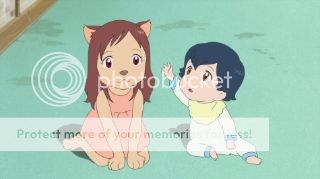Beginner's Guide: Mamoru Hosoda
In my last Beginner’s Guide, I spoke about the films of Studio Ghibli. Often called the “Disney of Japan”, Studio Ghibli has captivated anime fans around the world for roughly 30 years. But the question then becomes, “What else is out there?” It’s always hard recommending great films from other filmmakers to those who’ve seen and become enamoured of Studio Ghibli’s work. Still, while many fans point to the late-Satoshi Kon’s work for an answer, I’m gonna go a different route and go with something similar to Studio Ghibli, yet also different. Let’s talk about the works of a small-time director who’s up-and-coming in the anime world: Mamoru Hosoda.
Mamoru Hosoda, often touted as “the next Miyazaki,” only has three, major films under his belt to-date. This isn’t to say he doesn’t have a prior resume, he’d worked on several shows and TV-based features, but it’s in the last 8 or so years that he’s really started to make his mark. Like Hayao Miyazaki, Hosoda knows how to make clever, heartwarming films for the entire family. Like Hayao Miyazaki, Hosoda knows how to jam in a lot of emotional moments without being manipulative or forceful. Unlike Hayao Miyazaki, however, Hosoda’s movies are also much smaller in scale, focusing on family ties and relationships and not nostalgia or grand scale epics. He also writes his protagonists more believably than Miyazaki, with realistic people, and he has a fondness for the jitteriness of youth that celebrates their follies and their strengths.
The first of Hosoda’s films is 2006’s The Girl Who Leapt Through Time. A “Twilight Zone” type of story, it focuses on high school student Makoto Konno, a mysterious accident she has one day in school and her time travel abilities that occur as a result of it. As expected, she cockily uses her powers to erase her mistakes, much to the expense of her peers. It’s only through the consequences of her actions that she realizes that some mistakes aren’t worth fixing, and that she should learn from, and not correct, them. At roughly 99-minutes, the movie is Hosoda’s shortest.
Next is 2009’s Summer Wars, Hosoda’s action movie based loosely on a Digimon short he made in the early-2000’s. Taking place over one weekend in the Summer of 2010, the film follows genius Kenji Koiso, a rich girl named Natsuki Shinohara and her family’s celebration of their matriarch and rock’s 90th birthday amidst battling a military program named LOVE Machine that’s threatening to control the internet. The film delves into conspiracies and drama, as Natsuki’s family may be hiding a few secrets they weren’t truly honest about. Ultimately, it takes the combined effort of everyone to defeat LOVE Machine once-and-for-all. As a remake, it’s not terribly original, even copying scenes from its inspiration shot-for-shot. It’s also the laziest written of three, with plenty of clichés that you’d expect in Hollywood films. Still, it’s charming, relatively short for an action film (151-minutes), and while it’s my least-favourite of Hosoda’s works that doesn’t mean it isn’t good.
Finally, there’s 2012’s The Wolf Children, Hosoda most-recent work. The film centres around the 13 year struggle of Hana and her raising of two half-human/half-wolf children after her lover tragically dies. She initially raises them in her small apartment, but when her children prove to be a handful she leaves for the countryside to raise them there. In the end, she watches them grow and move in their own direction, much, at times, to her disapproval. At 117-minutes, the film is more free-structured and slice-of-life than Hosoda’s previous works. It’s also my favourite, and even rectifies the comically-drawn animation, Manga Iconography, flaw that bothers me about his other works. If anything, this is the one I’d recommend most to newcomers.
As expected, all of Hosoda’s movies are beautifully-animated, beautifully-composed and excellently-dubbed. The Girl Who Leapt Through Time features some of the best voice-acting from a Canadian dubbing studio, with Emily Hirst stealing the show as Makoto herself. Summer Wars and The Wolf Children, on the other hand, are FUNimation Entertainment productions, and anyone with knowledge of FUNimation’s acting stable will recognize voices like Brina Palencia, Maxey Whitehead, Colleen Clinkenbeard, David Mantraga and Micah Solusod, to name a few. Unfortunately, The Girl Who Leapt Through Time is the hardest to locate in English, due to its American distributor, Bandai Entertainment, ceasing distribution of anime in North America in the last few years. But the other two films should be easy to find in stores or online.
Ultimately, what makes Hosoda’s movies so great isn’t, as I said earlier, how big they are, because they’re not. Rather, it’s because they’re small and capture the minor details. Whether it’s watching someone get hit with a fire extinguisher, mourning the loss of a grandparent or running in the snow, Hosoda highlights the intricacies of life and the effect they have on his characters. That’s something that, for as much as I love his work, not even Hayao Miyazaki can do. Not to mention, as I also stated earlier, Hosoda understands adolescence in a way I’ve never seen in other anime films. And finally, his films, while tackling serious subjects, aren’t afraid to be light and fun, something I wish more movies wouldn’t be afraid to do.
Overall, any Mamoru Hosoda movie is simply a blast, and it’s an experience I’d recommend to anyone. So here’s to Hosoda’s work, and to hoping that his next movie is as good as his last three!
Mamoru Hosoda, often touted as “the next Miyazaki,” only has three, major films under his belt to-date. This isn’t to say he doesn’t have a prior resume, he’d worked on several shows and TV-based features, but it’s in the last 8 or so years that he’s really started to make his mark. Like Hayao Miyazaki, Hosoda knows how to make clever, heartwarming films for the entire family. Like Hayao Miyazaki, Hosoda knows how to jam in a lot of emotional moments without being manipulative or forceful. Unlike Hayao Miyazaki, however, Hosoda’s movies are also much smaller in scale, focusing on family ties and relationships and not nostalgia or grand scale epics. He also writes his protagonists more believably than Miyazaki, with realistic people, and he has a fondness for the jitteriness of youth that celebrates their follies and their strengths.
The first of Hosoda’s films is 2006’s The Girl Who Leapt Through Time. A “Twilight Zone” type of story, it focuses on high school student Makoto Konno, a mysterious accident she has one day in school and her time travel abilities that occur as a result of it. As expected, she cockily uses her powers to erase her mistakes, much to the expense of her peers. It’s only through the consequences of her actions that she realizes that some mistakes aren’t worth fixing, and that she should learn from, and not correct, them. At roughly 99-minutes, the movie is Hosoda’s shortest.
Next is 2009’s Summer Wars, Hosoda’s action movie based loosely on a Digimon short he made in the early-2000’s. Taking place over one weekend in the Summer of 2010, the film follows genius Kenji Koiso, a rich girl named Natsuki Shinohara and her family’s celebration of their matriarch and rock’s 90th birthday amidst battling a military program named LOVE Machine that’s threatening to control the internet. The film delves into conspiracies and drama, as Natsuki’s family may be hiding a few secrets they weren’t truly honest about. Ultimately, it takes the combined effort of everyone to defeat LOVE Machine once-and-for-all. As a remake, it’s not terribly original, even copying scenes from its inspiration shot-for-shot. It’s also the laziest written of three, with plenty of clichés that you’d expect in Hollywood films. Still, it’s charming, relatively short for an action film (151-minutes), and while it’s my least-favourite of Hosoda’s works that doesn’t mean it isn’t good.
Finally, there’s 2012’s The Wolf Children, Hosoda most-recent work. The film centres around the 13 year struggle of Hana and her raising of two half-human/half-wolf children after her lover tragically dies. She initially raises them in her small apartment, but when her children prove to be a handful she leaves for the countryside to raise them there. In the end, she watches them grow and move in their own direction, much, at times, to her disapproval. At 117-minutes, the film is more free-structured and slice-of-life than Hosoda’s previous works. It’s also my favourite, and even rectifies the comically-drawn animation, Manga Iconography, flaw that bothers me about his other works. If anything, this is the one I’d recommend most to newcomers.
As expected, all of Hosoda’s movies are beautifully-animated, beautifully-composed and excellently-dubbed. The Girl Who Leapt Through Time features some of the best voice-acting from a Canadian dubbing studio, with Emily Hirst stealing the show as Makoto herself. Summer Wars and The Wolf Children, on the other hand, are FUNimation Entertainment productions, and anyone with knowledge of FUNimation’s acting stable will recognize voices like Brina Palencia, Maxey Whitehead, Colleen Clinkenbeard, David Mantraga and Micah Solusod, to name a few. Unfortunately, The Girl Who Leapt Through Time is the hardest to locate in English, due to its American distributor, Bandai Entertainment, ceasing distribution of anime in North America in the last few years. But the other two films should be easy to find in stores or online.
Ultimately, what makes Hosoda’s movies so great isn’t, as I said earlier, how big they are, because they’re not. Rather, it’s because they’re small and capture the minor details. Whether it’s watching someone get hit with a fire extinguisher, mourning the loss of a grandparent or running in the snow, Hosoda highlights the intricacies of life and the effect they have on his characters. That’s something that, for as much as I love his work, not even Hayao Miyazaki can do. Not to mention, as I also stated earlier, Hosoda understands adolescence in a way I’ve never seen in other anime films. And finally, his films, while tackling serious subjects, aren’t afraid to be light and fun, something I wish more movies wouldn’t be afraid to do.
Overall, any Mamoru Hosoda movie is simply a blast, and it’s an experience I’d recommend to anyone. So here’s to Hosoda’s work, and to hoping that his next movie is as good as his last three!





Comments
Post a Comment